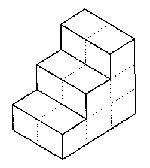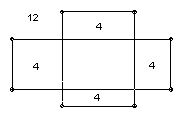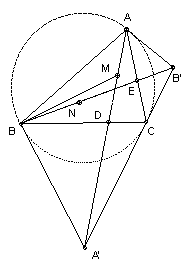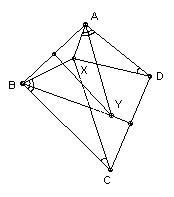|
|
|
Algebra
|
|
|
A2. a, b, c are positive integers such that b > 2a, c > 2b. Show that there is a real k such that the fractional parts of ka, kb, kc all exceed 1/3 and do not exceed 2/3.
|

|
|
A3. Find all pairs of real-valued functions f, g on the reals such that f(x + g(y) ) = x f(y) - y f(x) + g(x) for all real x, y.
|

|
|
A4. The function f on the non-negative integers takes non-negative integer values and satisfies f(4n) = f(2n) + f(n), f(4n+2) = f(4n) + 1, f(2n+1) = f(2n) + 1 for all n. Show that the number of non-negative integers n such that f(4n) = f(3n) and n < 2m is f(2m+1).
|

|
|
A6. 0 = a0 < a1 < a2 < ... and 0 = b0 < b1 < b2 < ... are sequences of real numbers such that: (1) if ai + aj + ak = ar + as + at, then (i, j, k) is a permutation of (r, s, t); and (2) a positive real x can be represented as x = aj - ai iff it can be represented as bm - bn. Prove that ak = bk for all k.
|

|
|
A7. A polynomial p(x) of degree 2000 with distinct real coefficients satisfies condition n if (1) p(n) = 0 and (2) if q(x) is obtained from p(x) by permuting its coefficients, then either q(n) = 0, or we can obtain a polynomial r(x) by transposing two coefficients of q(x) such that r(n) = 0. Find all integers n for which there is a polynomial satisfying condition n.
|

|
Combinatorics
|
|
|
C2. A piece is made of 12 unit cubes. It looks like a staircase of 3 steps, each of width 2. Thus the bottom layer is 2 x 3, the second layer is 2 x 2 and the top layer is 1 x 2. For which n can we make an n x n x n cube with such pieces?

|

|
|
C3. n > 3. S = {P1, ... , Pn} is a set of n points in the plane, no three collinear and no four concyclic. Let ai be the number of circles through three points of S which have Pi as an interior point. Let m(S) = a1 + ... + an. Show that the points of S are the vertices of a convex polygon iff m(S) = f(n), where f(n) is a value that depends only on n.
|

|
|
C4. Find the smallest number of pawns that can be placed on an n x n board such that no row or column contains k adjacent unoccupied squares. Assume that n/2 < k ≤ 2n/3.
|

|
|
C5. n rectangles are drawn in the plane. Each rectangle has parallel sides and the sides of distinct rectangles lie on distinct lines. The rectangles divide the plane into a number of regions. For each region R let v(R) be the number of vertices. Take the sum ∑ v(R) over the regions which have one or more vertices of the rectangles in their boundary. Show that this sum is less than 40n.

For example, for the two rectangles illustrated the sum is 28 < 80. Note that the unbounded outer region has 12 vertices, and we do not count the central region because it does not contain any vertices of the two rectangles.
|

|
|
C6. a and b are positive coprime integers. A subset S of the non-negative integers is called admissible if 0 belongs to S and whenever k belongs to S, so do k + a and k + b. Find f(a, b), the number of admissible sets.
|

|
Geometry
|
|
|
G1. Two circles C and C' meet at X and Y. Find four points such that if a circle touches C and C' at P and Q and meets the line XY at R and S, then each of the lines PR, PS, QR, QS passes through one of the four points.
|

|
|
G3. ABC is an acute-angled triangle with orthocenter H and circumcenter O. Show that there are points D, E, F on BC, CA, AB respectively such that OD + DH = OE + EH = OF + FH and AD, BE, CF are concurrent.
|

|
|
G4. Show that a convex n-gon can be inscribed in a circle iff there is a pair of real numbers ai, bi associated with each vertex Pi such that the distance between each pair of vertices PiPj with i < j is aibj - ajbi.
|

|
|
G5. ABC is an acute angled triangle. The tangent at A to the circumcircle meets the tangent at C at the point B'. BB' meets AC at E, and N is the midpoint of BE. Similarly, the tangent at B meets the tangent at C at the point A'. AA' meets BC at D, and M is the midpoint of AD. Show that ∠ABM = ∠BAN. If AB = 1, find BC and AC for the triangles which maximise ∠ABM.

|

|
|
G6. ABCD is a convex quadrilateral. The perpendicular bisectors of AB and CD meet at Y. X is a point inside ABCD such that ∠ADX = ∠BCX < 90o and ∠DAX = ∠CBX < 90o. Show that ∠AYB = 2 ∠ADX.

|

|
|
G7. Ten gangsters are standing in a field. The distance between each pair of gangsters is different. When the clock strikes, each gangster shoots the nearest gangster dead. What is the largest number of gangsters that can survive?
|

|
Number theory
|
|
|
N1. Find all positive integers n > 1 such that if a and b are relatively prime then a = b mod n iff ab = 1 mod n.
|

|
|
N2. Find all positive integers n such that the number of positive divisors of n is (4n)1/3.
|

|
|
N4. Find all positive integers a, m, n such that am + 1 divides (a + 1)n.
|

|
|
N5. Show that for infinitely many positive integers n, we can find a triangle with integral sides whose semiperimeter divided by its inradius is n.
|

|
|
N6. Show that all but finitely many positive integers can be represented as a sum of distinct squares.
|

|
|
Note: problems A1, A5, C1, G2, G8 and N3 were used in the Olympiad and are not shown here.
|
|




